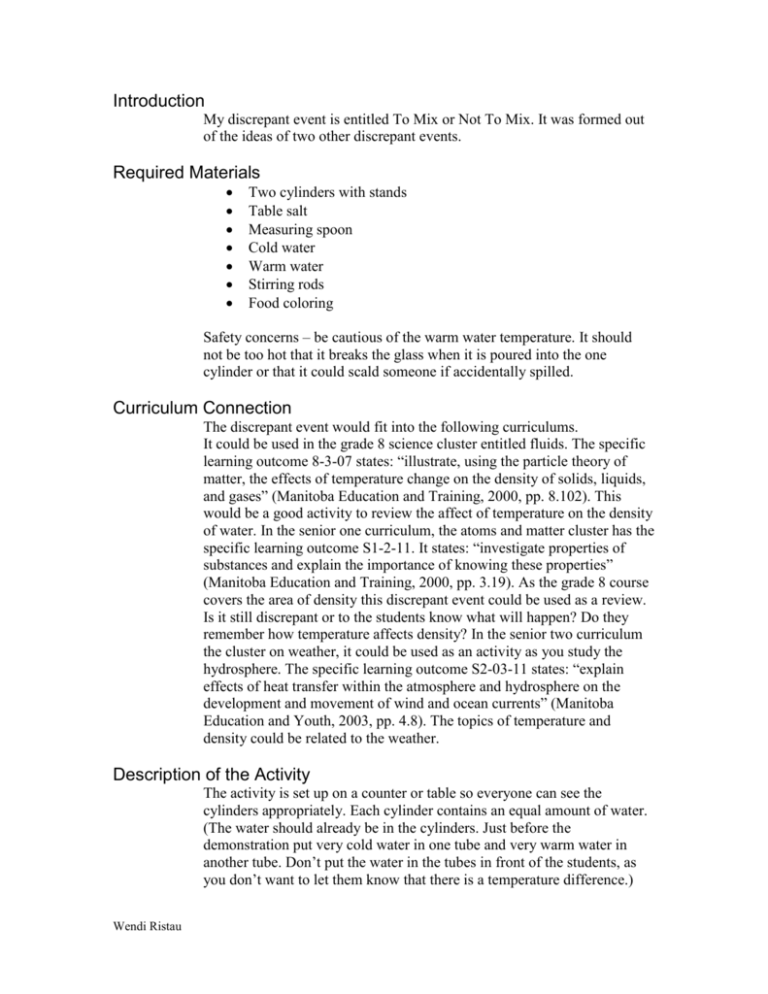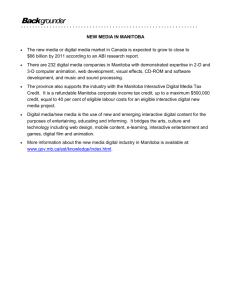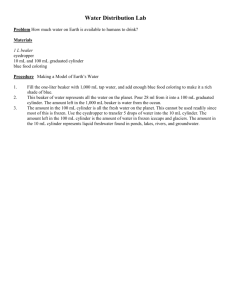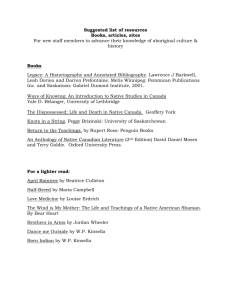To Mix or Not to Mix - Discrepant Event
advertisement

Introduction My discrepant event is entitled To Mix or Not To Mix. It was formed out of the ideas of two other discrepant events. Required Materials Two cylinders with stands Table salt Measuring spoon Cold water Warm water Stirring rods Food coloring Safety concerns – be cautious of the warm water temperature. It should not be too hot that it breaks the glass when it is poured into the one cylinder or that it could scald someone if accidentally spilled. Curriculum Connection The discrepant event would fit into the following curriculums. It could be used in the grade 8 science cluster entitled fluids. The specific learning outcome 8-3-07 states: “illustrate, using the particle theory of matter, the effects of temperature change on the density of solids, liquids, and gases” (Manitoba Education and Training, 2000, pp. 8.102). This would be a good activity to review the affect of temperature on the density of water. In the senior one curriculum, the atoms and matter cluster has the specific learning outcome S1-2-11. It states: “investigate properties of substances and explain the importance of knowing these properties” (Manitoba Education and Training, 2000, pp. 3.19). As the grade 8 course covers the area of density this discrepant event could be used as a review. Is it still discrepant or to the students know what will happen? Do they remember how temperature affects density? In the senior two curriculum the cluster on weather, it could be used as an activity as you study the hydrosphere. The specific learning outcome S2-03-11 states: “explain effects of heat transfer within the atmosphere and hydrosphere on the development and movement of wind and ocean currents” (Manitoba Education and Youth, 2003, pp. 4.8). The topics of temperature and density could be related to the weather. Description of the Activity The activity is set up on a counter or table so everyone can see the cylinders appropriately. Each cylinder contains an equal amount of water. (The water should already be in the cylinders. Just before the demonstration put very cold water in one tube and very warm water in another tube. Don’t put the water in the tubes in front of the students, as you don’t want to let them know that there is a temperature difference.) Wendi Ristau The amount of water and salt you use will depend on the size of your cylinders. I used 50 ml of water with ¼ tsp of salt in each cylinder. Explain that you have two cylinders filled with equal amounts of water. State that you will add equal amounts of salt to each cylinder and then mix each cylinder. Complete these steps. Then ask the students what will happen to the water if you add a few drops of food coloring (prediction part of POE model). Add the food coloring. Ask the students to watch the color of the water in each cylinder and to be able to tell you what they see (observe part of POE model). The students should find that the food coloring in one cylinder stays near the top of the water while, in the other cylinder, the food coloring disperses throughout the cylinder. Ask the students what happened? Is this what they expected? Why did this happen? What might cause the difference between the two cylinders? (These questions and the following discussion are the explain portion of the POE model). I would then explain that the density is different and that is why the food coloring did not disperse. The density is different because one is cold and one contains warm water. To help the event make more sense, I could use the analogue of how if you have hot chocolate, chocolate will start to accumulate on the bottom as the drink cools. Theoretical Background The density of the water is being increased by the addition of the salt (Science at Home, 2003). But then the temperature density is changed even more as a temperature difference is introduced. As a liquid is heated the molecules move around more quickly and there is an increase in the volume of the water (Dorin, Demmin, & Gabel, 1989). The density of the liquid decreases as its’ volume increases (Dorin, Demmin, & Gabel, 1989). Water is at its densest 4 degrees Celsius (Dorin, Demmin, & Gabel, 1989). Subsequently, the food coloring disperses much more easily through the cylinder with the warm water. How is the Event Discrepant? The event would cause disequilibria in students in the following manner. Due to the fact that equal amounts of water and salt have been put in the cylinders the students would expect them to react in the same way. But they do not. The students will have to make some guesses as to how the two cylinders may be different. Some students may expect the food coloring to disperse while others may have expected the food coloring to stay on the top because of the addition of the salt to the water. This would spark their curiosity. Wendi Ristau References Bucshmann, N. (1999). Layers of Water. Retrieved on January 25, 2004 from: http://tiger.coe.missouri.edu/~pgermann/DiscEvent/Density/Layers _of_Water/layers_of_w… Dorin, H, Demmin, P.E., & Gabel, D.E. (1989). Prentice Hall Chemistry: The Study of Matter. Prentice Hall, Inc.: Needham, MA. Manitoba Education and Training (2000). Grade 5 to 8: A Foundation for Implementation. Retrieved on January 24, 2004 from: http://www2.edu.gov.mb.ca/ks4/cur/science/default.asp Manitoba Education and Training (2000). Senior 1 Science: Manitoba Curriculum Framework of Outcomes. Manitoba Education and Training: Winnipeg, MB. Manitoba Education and Youth (2003). Senior 2 Science: Manitoba Curriculum Framework of Outcomes. Retrieved on January 24, 2004 from: http://www2.edu.gov.mb.ca/ks4/cur/science/defaults.asp Science at Home (2003). Density Meter. Retrieved on January 25, 2004 from: http://scienceathome.cienciaviva.pt/medidensidade_eng.html Voelker, C. (n.d.). Hot vs. Cold. Retrieved January 8, 2004 from: http://tiger.coe.missouri.edu/~pgermann/DiscEvent/Density/Hot_vs._Cold /hot_vs._cold.html Wendi Ristau







